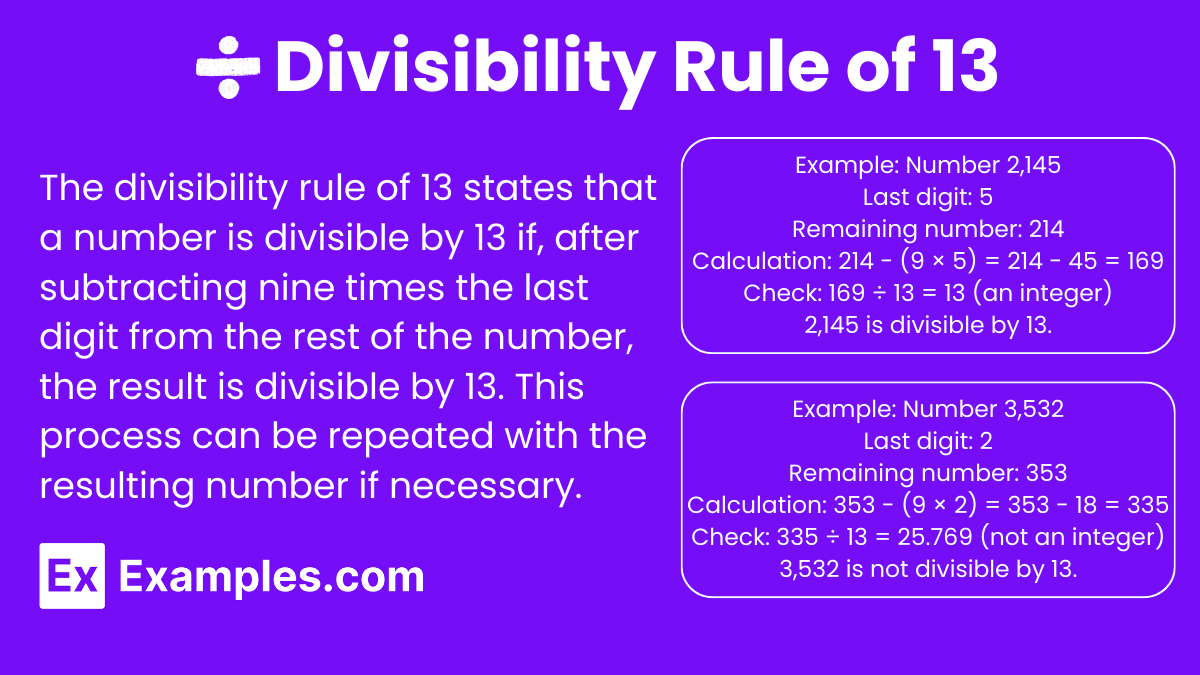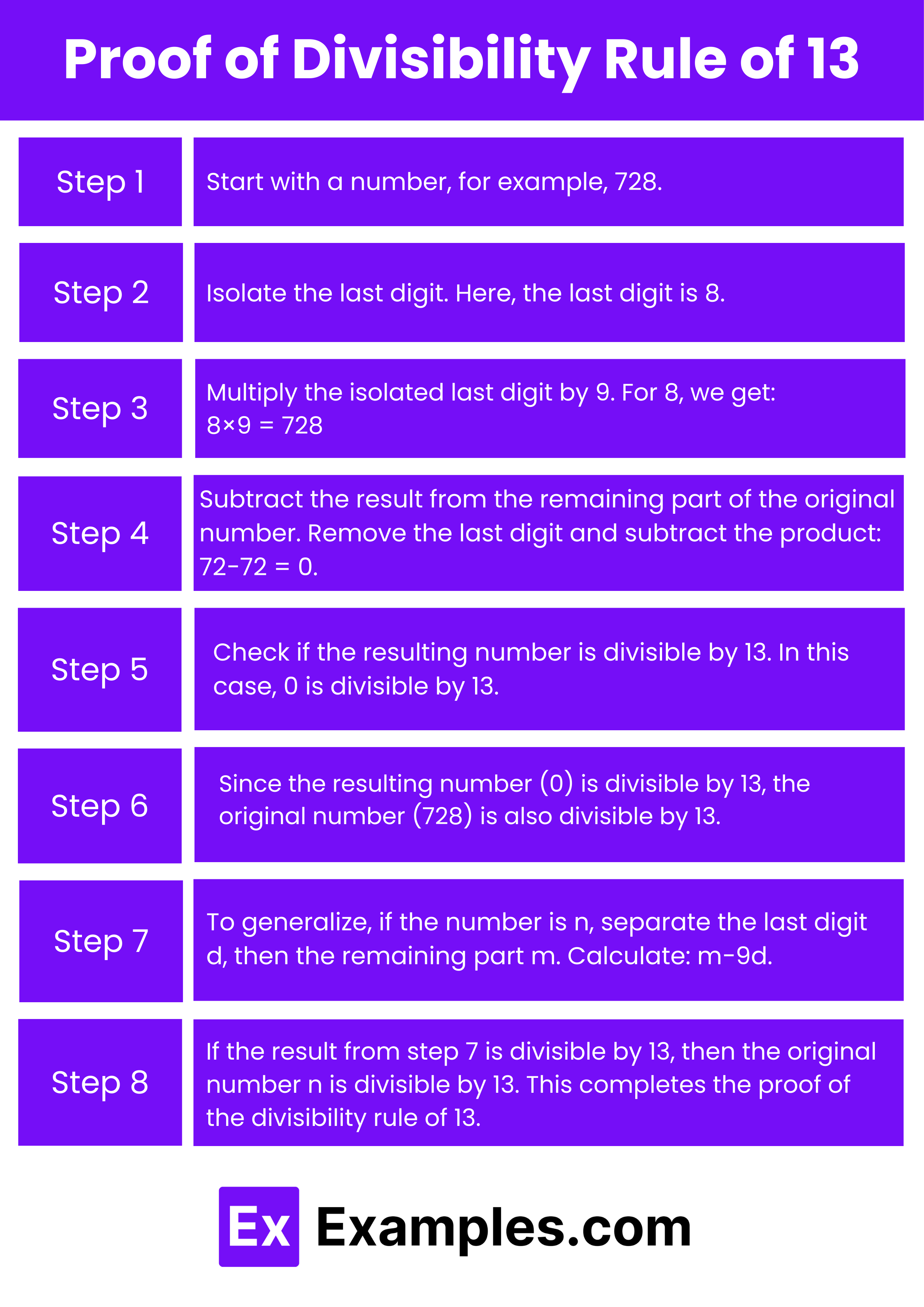Which of the following numbers is divisible by 13?
156
132
178
124


The divisibility rule of 13 is a method to determine if a number is divisible by 13 without performing the division. To check, subtract nine times the last digit from the rest of the number; if the result is divisible by 13, then the original number is too. Understanding divisibility rules is crucial in mathematics, especially in topics like rational and irrational numbers, algebra, integers, addition, subtraction, multiplication, and division. These concepts form the foundation for solving more complex problems and improving numerical fluency.
Download Proof of the Divisibility Rule of 13 in PDF

Download Proof of the Divisibility Rule of 13 in PDF
Start with a number, for example, 728.
Isolate the last digit. Here, the last digit is 8.
Multiply the isolated last digit by 9. For 8, we get: 8×9 = 728
Subtract the result from the remaining part of the original number. Remove the last digit and subtract the product: 72−72 = 0.
Check if the resulting number is divisible by 13. In this case, 0 is divisible by 13.
Since the resulting number (0) is divisible by 13, the original number (728) is also divisible by 13.
To generalize, if the number is n, separate the last digit d, then the remaining part m. Calculate: m−9d
If the result from step 7 is divisible by 13, then the original number n is divisible by 13. This completes the proof of the divisibility rule of 13.
To determine if a number is divisible by 13, follow these steps:
Consider the number 351:
Thus, 351 is divisible by 13.
To determine if a number is divisible by 14, follow these steps:
Consider the number 98:
Check Divisibility by 2: 98 is even.
Check Divisibility by 7:
Since 98 is divisible by both 2 and 7, it is divisible by 14.
Example: To check if 2,366 is divisible by 13:
Since 182 is divisible by 13, 2,366 is also divisible by 13.
Example: To check if 3,246 is divisible by 17:
Since 294 is not divisible by 17, 3,246 is also not divisible by 17.
Since 182 is divisible by 13, 2,366 is also divisible by 13.
Since 444 is not divisible by 13, 4,713 is not divisible by 13.
Since 91 is divisible by 13, 1,092 is also divisible by 13.
Since 501 is not divisible by 13, 5,101 is not divisible by 13.
Since 304 is not divisible by 13, 3,859 is not divisible by 13.
To quickly determine if a number is divisible by 13, remove the last digit, multiply it by 9, and subtract this product from the remaining number. If the result is divisible by 13, then the original number is also divisible by 13.
Sure! For example, to check if 2,366 is divisible by 13:
Remove the last digit (6) and the remaining number is 236.
Multiply the last digit by 9: 6 × 9 = 54.
Subtract 54 from 236: 236 – 54 = 182.
Since 182 is divisible by 13 (182 ÷ 13 = 14), 2,366 is also divisible by 13.
The rule works because of the mathematical properties of numbers in relation to their decimal system positions. By manipulating the last digit and the remaining number, the rule leverages these properties to determine divisibility by 13.
For large numbers, you can repeat the divisibility rule multiple times until you get a smaller number that’s easier to evaluate. This iterative process simplifies the calculation.
Common mistakes include incorrect multiplication of the last digit by 9, incorrect subtraction, and not properly checking if the result is divisible by 13.
Yes, the divisibility rule of 13 can be applied to negative numbers in the same way as positive numbers. Follow the same steps, and if the result is divisible by 13, the original number is also divisible by 13.
The divisibility rule of 13 is useful in various mathematical problems, number theory, and simplifying complex calculations. It also helps in quick mental math checks without a calculator.
Yes, another method involves breaking the number into smaller parts, multiplying and adding or subtracting them in a specific pattern to check for divisibility. However, the rule involving the last digit is typically simpler and more straightforward.
To practice, try applying the rule to different numbers and verifying the results by actual division. Work on progressively larger numbers to build confidence and accuracy in using the rule.
Text prompt
Add Tone
10 Examples of Public speaking
20 Examples of Gas lighting
Which of the following numbers is divisible by 13?
156
132
178
124
What is the remainder when 265 is divided by 13?
5
6
7
8
Which number is NOT divisible by 13?
286
312
377
404
If a number ends in 1 and is divisible by 13, which of the following numbers could it be?
161
171
182
193
What is the smallest number greater than 100 that is divisible by 13?
104
117
130
143
If a number is divisible by 13, what must be true about its digits sum?
The sum must be divisible by 13
The number itself must be divisible by 13
The difference of its digits must be divisible by 13
The sum of its digits must be a multiple of 13
Which of the following numbers is divisible by 13?
462
520
547
624
What is the result of dividing 143 by 13?
10
11
12
13
Which number below is divisible by 13?
234
260
273
296
What is the largest number less than 500 that is divisible by 13?
487
468
455
442
Before you leave, take our quick quiz to enhance your learning!

